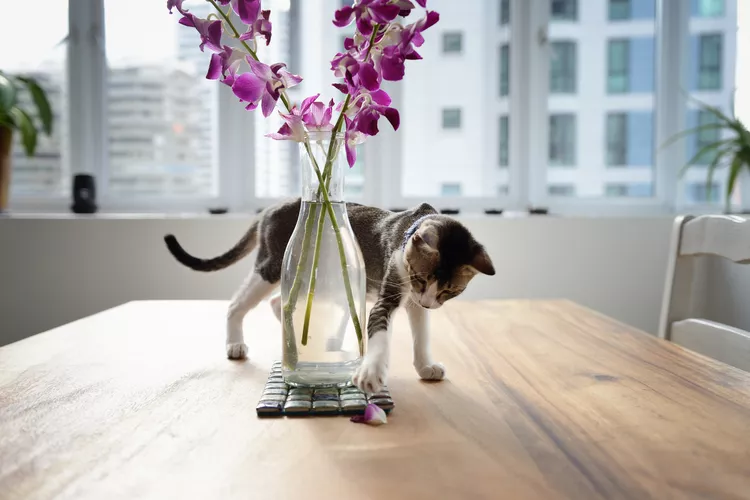- 01 of 09
Orchids
Orchids are beautiful houseplants that come in a variety of vibrant colors and species and are readily available for purchase. These bright flowering plants are tall and delicate but are also safe to have around cats. They require very little water and should not be kept in direct sunlight but a little humidity in a warm environment is preferred. Orchids don't take up much table or floor space but they do get quite tall.
- 02 of 09
African Violets
A classic tabletop houseplant, these plants with small flowers are often seen in garden centers in small pots. They are known for their small purple or pink flowers but can come in a variety of colors as well. Different varieties of African violets may have differently shaped leaves and are sometimes confused with another type of plant called Gloxinia, which is also non-toxic to cats. African violets do best in bright sunlight in a place that is warm and humid. They don't take up very much space and are typically inexpensive.
- 03 of 09
Spider Plants
Spider plants have been popular houseplants for decades thanks to their fun, hanging appendages. These leafy plants can be hung from the ceiling or set on a shelf allowing the plantlets to dangle. These plants are also easy to care for since they don't demand a lot of sunlight or specific temperatures. Even if your cat takes an interest in the hanging plantlets that grow from the spider plant, it's good to know that these plants are safe to have around your feline friends.
- 04 of 09
Boston Ferns
Another classic houseplant that is easily found in garden centers and home improvement stores, the Boston fern is a full, leafy plant that easily fills an empty space in a windowsill. Cats may bat at the leaves so it is good to know that this plant is not toxic to them if they were to munch on a fallen leaf. Boston ferns enjoy humidity and bright but indirect light but temperatures are not that much of a concern if your house gets a little cooler in the winter. Repotting in the spring is recommended to keep these plants happy, even if they haven't outgrown their current pot, and you can separate the plant into multiple plants at this time to create an even larger greenspace for you and your cat to enjoy.
Continue to 5 of 9 below - 05 of 09
Polka Dot Plants
Hypoestes phyllostachya is the scientific name for this fun houseplant commonly known as a polka dot plant. It's vibrantly colored leaves have patterns that look like freckles or dots making it a unique option to add a little more color to a leafy green space. Polka dot plants are safe if a cat were to chew on its leaves but if they eat a large amount of the plant, some vomiting and/or diarrhea may result. These plants like bright light and if they aren't in enough light they won't develop the classic patterned leaves so if your polka dot plant only has solid green leaves growing, it's a sign you should give it more light.
- 06 of 09
Bromeliads
Bromeliads come in a variety of colors and even patterns and are starting to be found more regularly in homes. While these plants are non-toxic to cats in small amounts, eating a large amount of the leaves can lead to GI upset including vomiting or diarrhea. The variety is the most commonly seen type of bromeliad. These plants like similar conditions as orchids so many people end up having both types of houseplants in their collection. Bromeliads need bright but indirect sunlight and fast-draining soil to thrive but are adaptable to a much wider variety of temperatures than you would think since they are naturally found in rainforests.
- 07 of 09
Haworthias
Succulents are very popular houseplants because of their variety of shapes, textures, and low-maintenance. Haworthia is also known as the zebra cactus but it doesn't have those prickly spines often seen on other cacti. This succulent is a great option for homes with cats, especially if your space is small. Haworthias come in different sizes with some only needing the space of a teacup to live. They do like bright, indirect light, but like most cacti, these plants don't need much water, especially in the winter months.
- 08 of 09
Gloxinias
Sometimes confused with African violets, Gloxinia is a colorful houseplant that is also safe for cats. The flowers are more bell-like than African violets but the same lamb's ear-like leaves are also found on this houseplant. These plants do best in indirect but bright light and needs constantly moist soil with temperatures staying in the 70's.
Continue to 9 of 9 below - 09 of 09
Areca Palms
If you are looknig for a larger houseplant that is safe to have around your cat then you may consider an areca palm. These trees need bright but indirect light alongside moist soil and a lot of nutrients. They may not be the easiest to care for if your thumb isn't very green but they are wonderful for creating a large indoor greenspace that's also safe for a cat.
While there are a plethora of safe houseplants for cats, there are also some plants that can be very toxic. Be sure to research the plant you plan on purchasing before adding it to your home. Some examples of toxic houseplants for cats include lilies, azaleas, crocuses, birds of paradise, carnations, chrysanthemums, daisies, daffodils, dalias, sago palms, and many more. If your cat ate a plant and you aren't sure if it is toxic, contact your veterinarian or a pet poison hotline as soon as possible.




















